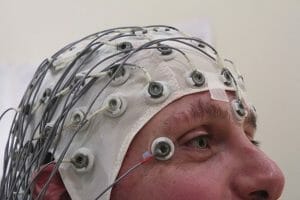Paroxysm Definition
A paroxysm, also known as a paroxysmal attack, is a sudden attack or reemergence of symptoms. Paroxysms occur with many different medical conditions, and the symptoms of a paroxysm vary depending on the specific condition. Medical conditions where paroxysms may occur include multiple sclerosis, pertussis (whooping cough), epilepsy, and asthma. Some medical conditions feature the word paroxysm in their name because it is a major component of these conditions, such as paroxysmal atrial fibrillation, which is when the atria of the heat lose their rhythm and beat irregularly.
The word paroxysm can also be used to describe a sudden outburst of emotion, such as an outburst of laughter or rage.
Examples of Paroxysmal Disorders
Paroxysmal Dyskinesias
Paroxysmal dyskinesias (PD) are movement disorders. A person with PD has abnormal movements only during a paroxysmal attack. There are four different types of paroxysmal movements associated with PD, and a person may exhibit one or more types. They are:
- Dystonic: patterned and repetitive
- Choreic: quick and involuntary, similar to fidgeting
- Ballistic: involve whole portions of a limb, such as a movement of the hip and knee
- Athetoid: slow, most commonly involve the hands
PD can be inherited, but it can also appear sporadically. It is caused by improper function of the basal ganglia, a part of the brain that plays a role in motor movements. However, the exact causes are not known.
Paroxysmal Atrial Fibrillation
Paroxysmal atrial fibrillation (Paroxysmal AFib) is a condition in which the atria (the two upper chambers of the heart) beat irregularly instead of in a normal rhythm for a period of time lasting from minutes to days. Paroxysmal AFib can be caused by heart damage from heart disease or hypertension. It can also be caused by an overactive thyroid, heart valve defects, binge drinking, low potassium, or stimulants like caffeine. Symptoms associated with paroxysmal AFib include lightheadedness, feeling one’s heart pounding, and chest pain. If left untreated, more serious complications could occur such as stroke, blood clots, or even heart failure.
Benign Paroxysmal Positional Vertigo
Benign Paroxysmal Positional Vertigo (BPPV) is a condition where people experience for brief periods a false sense that they are spinning. People who suffer from BPPV may feel dizzy, lightheaded, unsteady, and nauseous. It is caused by calcium carbonate crystals dislodging in the inner ear, which is the area of the body that sends signals to the brain to create a sense of balance. This “tells” the brain that the head is moving, even though it is not, and this causes a spinning sensation. Most cases do not occur from any apparent cause, but BPPV is known to be associated with ear infection, migraine headaches, diabetes, and osteoporosis. It is treated by guided head movements to put the crystals back in place.
Other Conditions that Feature Paroxysms
These are examples of medical conditions that are not defined by paroxysmal actions, but in which paroxysms may occur.
Multiple Sclerosis
Multiple sclerosis (MS) is a disease in which a person’s brain and spinal cord nerves become damaged over time. It is a progressive disease, with onset usually between age 20 and 50, and there is no cure. Many symptoms of MS are paroxysmal and appear or reappear suddenly for a period of seconds to minutes. They include itching, tingling, and burning sensations, pains in the arms and legs, spasms, lack of coordination, and speech and vision problems.
Pertussis
Pertussis, or whooping cough, has three stages: catarrhal, paroxysmal, and convalescent. In the catarrhal stage, an afflicted person will have a low fever and occasional coughs. During the paroxysmal stage, the coughs become paroxysmal; they are severe and occur for short bursts, and occur on average 15 times per day. During the convalescent stage, a person will slowly recover, but paroxysms can still reoccur for months afterward.
Epilepsy
Epilepsy is a chronic disorder that is characterized by recurring seizures. Some cases of epilepsy are genetic, while others are caused by tumors, strokes, head injuries, or birth defects. When a seizure occurs, neurons in the brain fire abnormally, resulting in too much brain activity. The neurons become depolarized in a paroxysmal depolarizing shift, and this causes a person to shake uncontrollably for seconds to minutes. It is treated with taking medication daily.

An EEG cap is used to determine the source of abnormal brain waves in a person suffering from epilepsy.
Asthma
Asthma is an inflammatory disease that affects the airways of the lungs and makes it difficult to breathe for short periods of time. People who have asthma have sudden paroxysms of wheezing, coughing, and difficulty breathing, usually at night. Asthma attacks are treated by using inhalers that contain medication. They can sometimes be prevented by avoiding certain triggers like cigarette smoke or pets.
Related Biology Terms
- Dyskinesia – A movement disorder with involuntary movements and accompanied by less control over voluntary movements.
- Fibrillation – Irregular contractions of muscle fibers.
- Paroxysmal depolarizing shift – A change in electrical charge in neurons that occurs during an epileptic seizure.
- Basal ganglia – A part of the brain that has roles in movement, procedural learning, habits, and emotions, among others.
Quiz
1. Paroxysms play a role in all of the following medical conditions except:
A. Asthma
B. Pertussis
C. Diabetes
D. Multiple sclerosis
2. What is paroxysmal atrial fibrillation?
A. The heart beats irregularly for short periods of time.
B. Nerves in the brain and spinal cord become damaged over time.
C. Abnormal movements occur.
D. A spinning sensation is felt when the body is not moving.
3. Which is NOT a stage of pertussis?
A. Catarrhal
B. Vestigial
C. Convalescent
D. Paroxysmal
